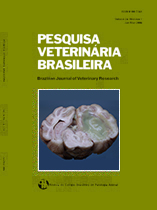 |
|
|
|
Year 2017 - Volume 37, Number 8
|

|
Ruminal parameters and nitrogen balance in fed cattle feeding with cassava root silage, 37(8):883-890
|
ABSTRACT.- Vieira P.A.S., Azevêdo J.A.G., Silva F.F., Pereira L.G.R., Neves A.L.A., Santos A.B., Souza L.L. & Santos R.D. 2017. [Ruminal parameters and nitrogen balance in fed cattle feeding with cassava root silage.] Parâmetros ruminais e balanço de nitrogênio em bovinos alimentados com silagem da raiz de mandioca. Pesquisa Veterinária Brasileira 37(8):883-890. Departamento de Ciências Agrárias e Ambientais, Universidade Estadual de Santa Cruz, Campus Soane Nazaré de Andrade, Rodovia Jorge Amado Km 16, Bairro Salobrinho, Ilhéus, BA 45662-900, Brazil. E-mail: augustog@uesc.br
The effect of inclusion of cassava root silage on ruminal parameters and nitrogenous compounds in dairy cattle was evaluated. Five cattle cannulated in the rumen and with average body weight of 389 kg were distributed into a Latin square 5x5, with five levels of inclusion (0.00, 3.62, 7.23, 10.84 and 14.54% of the diet dry matter) of cassava root silage and five periods (10 days for adaptation and five days for data collection). The nitrogen excretion in urine and feces were not affected (P>0.05) by inclusion of cassava root silage in the diet. The total nitrogen intake (CNT) and nitrogen balance (NB) showed an increasing quadratic and linear behavior, respectively. The lowest CNT (142.14g/day) was obtained with the inclusion of 5.82% silage cassava root. The concentration of urea (U) and urea nitrogen (UN) in plasma and urine did not change (P>0.05). There was a quadratic behavior (P<0.05) in excreta of U and NU in the urine, with minimum point of 131.13 and 61.20g/day respectively, at the level of 7.27% inclusion of the cassava root silage. No interaction (P>0.05) was between the levels of cassava root silage and the collection time of rumen contents for the short-chain fatty acids, pH and ammonia nitrogen (NH3-N). Only the N-NH3 protein showed quadratic behavior, according to the inclusion levels, with the minimum point (12.62mg/100ml of rumen contents) at the level of 5.98%. The level of 7.23% of cassava root silage in the diet was more efficient with the use of nitrogen compounds. The diets contribute similarly to the production of short chain fatty acids, without disturbing the rumen pH. |
| |
|
|
| |
|
 |